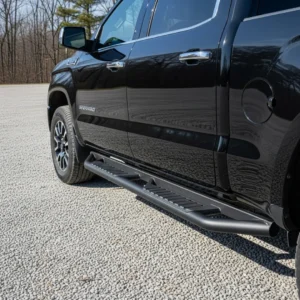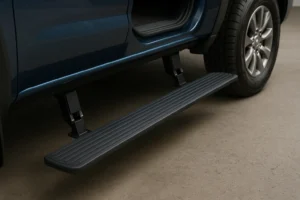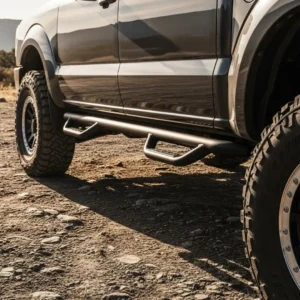If you’ve ever wondered what are running boards on truck and why so many pickups and SUVs have them, you’re not alone. These handy accessories are more than just stylish additions they provide functionality, safety, and protection. Whether you’re upgrading your truck for better accessibility or looking for a sleek new look, running boards could be the perfect addition.
In this blog, we’ll cover everything you need to know about running boards: what they are, their benefits, the different types available, and whether they’re worth installing on your truck.
What Is a Running Board on a Truck?
A running board is a flat or slightly curved step mounted along the lower side of a truck or SUV, just beneath the doors. Its primary purpose is to act as a step assist, making it easier to get in and out of taller vehicles. Running boards were common in older vehicles, and they’ve made a strong comeback in today’s trucks especially lifted or full-size models.
They’re practical, stylish, and even protective offering value for both daily drivers and off-road enthusiasts.
Benefits of Running Boards
Running boards offer multiple benefits that go beyond appearance:
1. Easier Access
If your truck sits high off the ground, climbing in and out can be a challenge. Running boards give passengers, especially kids and seniors a stable step for safer entry and exit.
2. Protects Your Truck’s Lower Body
Running boards act as a barrier against rocks, road salt, and mud that get kicked up by the tires. This helps prevent scratches, paint chips, and long-term corrosion.
3. Enhances Your Truck’s Style
Today’s running boards are available in sleek designs and various finishes like matte black, chrome, or stainless steel. They can add a rugged, sporty, or luxury look to your vehicle.
4. Keeps Interiors Cleaner
Passengers can use the running board to wipe off dirt and mud before stepping inside, helping to keep your truck’s interior clean.
Types of Running Boards for Trucks
There are several styles of running boards to choose from:
- Fixed Running Boards:
The most common type, permanently mounted and always visible. Durable and easy to install.
- Retractable Running Boards:
These high-end options automatically extend when the door opens and retract when it closes offering a clean, seamless appearance.
- Nerf Bars (Side Steps):
Tubular-shaped alternatives to running boards, offering a sportier and more rugged look.
What Are Running Boards Made Of?
The material of your running board affects its strength, weight, and longevity:
- Aluminum: Lightweight and rust-resistant great for all-weather durability.
- Steel: Strong and tough, but requires a protective coating to resist rust.
- Plastic with Metal Core: Cost-effective and corrosion-resistant, but not as sturdy for heavy-duty use.
- Stainless Steel: Heavy-duty and highly corrosion-resistant with a polished look that stands out.
Are Running Boards Worth Installing?
If you’re driving a truck with higher ground clearance or often travel with passengers, running boards are definitely worth considering. They offer convenience, enhance safety, protect your vehicle’s exterior, and improve the overall look of your truck.
While some drivers may worry about reduced ground clearance, many modern running boards are designed to be low-profile and aerodynamic. Retractable versions are also great for off-roaders who want the function without the bulk.
Installation: DIY or Professional?
Many running boards come with easy bolt-on kits and can be installed at home using simple tools. However, powered or retractable running boards may require professional installation due to electrical wiring and motor components.
To sum it up, if you’ve been asking what are running boards on truck, they are essential accessories that blend function, protection, and style. Whether you drive your truck for work, adventure, or everyday travel, running boards make life easier and better-looking.
For top-quality truck accessories including premium running boards, check out Scorpion Truck Stuff, your trusted partner in taking your truck to the next level.




